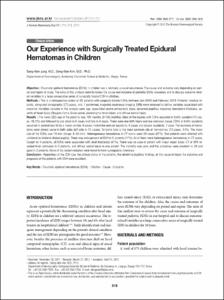KUMEL Repository
1. Journal Papers (연구논문)
1. School of Medicine (의과대학)
Dept. of Neurosurgery (신경외과학)
Our Experience with Surgically Treated Epidural Hematomas in Children
- Keimyung Author(s)
- Kim, Dong Won
- Department
- Dept. of Neurosurgery (신경외과학)
- Journal Title
- Journal of Korean Neurosurgical Society
- Issued Date
- 2012
- Volume
- 51
- Issue
- 4
- Keyword
- Traumatic epidural hematomas (EDHs); Children; Cause; Outcome
- Abstract
- Objective
Traumatic epidural hematomas (EDHs) in children are a relatively unusual occurrence. The cause and outcome vary depending on period and region of study. The aims of this analysis were to review the cause and outcome of pediatric EDHs nowadays and to discuss outcome-related variables in a large consecutive series of surgically treated EDH in children.
Methods
This is a retrospective review of 29 patients with surgically treated EDHs between Jan 2000 and February 2010. Patients' medical records, computed tomographic (CT) scans, and, if performed, magnetic resonance imaging (MRI) were reviewed to define variables associated with outcome. Variables included in the analysis were age, associated severe extracranial injury, abnormal pupillary response, hematoma thickness, severity of head injury (Glasgow Coma Scale score), parenchymal brain injury, and diffuse axonal injury.
Results
The mean (SD) age of the patients was 109 months (0-185 months). Most of the injuries with EDHs occurred in traffic accident (14 cases, 48.2%) and followed by slip down in 6 cases and falls in 6 cases. There were one birth injury and one unknown cause. EDHs in traffic accidents occurred in pedestrians hit by a motor vehicle, 9 cases; motorbike and car accidents, 5 cases and bicycle accidents, 1 case. The locations of hematoma were almost same in both sides (left side in 15 cases). Temporal lobe is the most common site of hematomas (13 cases, 44%). The mean size of the EDHs was 18 mm (range, 5-40 mm). Heterogeneous hematomas in CT scans were 20 cases (67%). Two patients were referred with unilateral or bilateral dilated pupil(s). There was enlargement of EDH in 5 patients (17%). All of them were heterogeneous hematomas in CT scans. Except for 4 patients, all EDHs were associated with skull fracture(s) (87%). There was no case of patient with major organ injury. CT or MRI revealed brain contusion in 5 patients, and diffuse axonal injury in one patient. The mortality was zero, and the outcomes were excellent in 26 and good in 2 patients. None of the tested variables were found to have a prognostic relevance.
Conclusion
Regardless of the EDH size, the clinical status of the patients, the abnormal pupillary findings, or the cause of injury, the outcome and prognosis of the patients with EDH were excellent.
Keywords: Traumatic epidural hematomas (EDHs), Children, Cause, Outcome
- Keimyung Author(s)(Kor)
- 김동원
- Publisher
- School of Medicine
- Citation
- Sang-Won Jung and Dong-Won Kim. (2012). Our Experience with Surgically Treated Epidural Hematomas in Children. Journal of Korean Neurosurgical Society, 51(4), 215–218. doi: 10.3340/jkns.2012.51.4.215
- Type
- Article
- ISSN
- 2005-3711
- Appears in Collections:
- 1. School of Medicine (의과대학) > Dept. of Neurosurgery (신경외과학)
- 파일 목록
-
-
Download
 oak-aaa-4776.pdf
기타 데이터 / 457.4 kB / Adobe PDF
oak-aaa-4776.pdf
기타 데이터 / 457.4 kB / Adobe PDF
-
Items in Repository are protected by copyright, with all rights reserved, unless otherwise indicated.